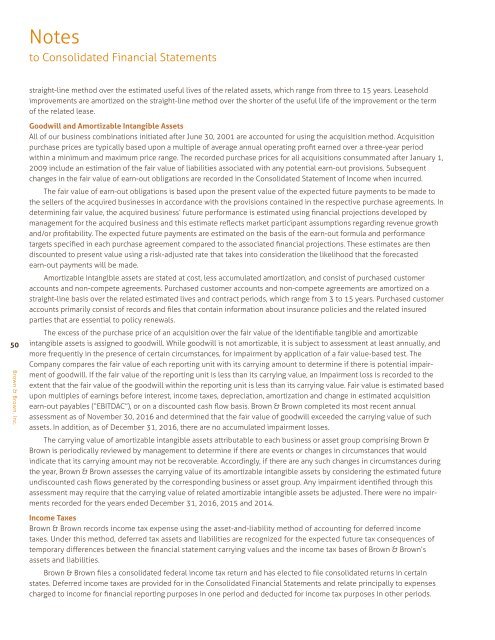Brown & Brown Insurance 2016 Annual Report
2016 Annual Report
2016 Annual Report
You also want an ePaper? Increase the reach of your titles
YUMPU automatically turns print PDFs into web optimized ePapers that Google loves.
Notes<br />
to Consolidated Financial Statements<br />
straight-line method over the estimated useful lives of the related assets, which range from three to 15 years. Leasehold<br />
improvements are amortized on the straight-line method over the shorter of the useful life of the improvement or the term<br />
of the related lease.<br />
50<br />
<strong>Brown</strong> & <strong>Brown</strong>, Inc.<br />
Goodwill and Amortizable Intangible Assets<br />
All of our business combinations initiated after June 30, 2001 are accounted for using the acquisition method. Acquisition<br />
purchase prices are typically based upon a multiple of average annual operating profit earned over a three-year period<br />
within a minimum and maximum price range. The recorded purchase prices for all acquisitions consummated after January 1,<br />
2009 include an estimation of the fair value of liabilities associated with any potential earn-out provisions. Subsequent<br />
changes in the fair value of earn-out obligations are recorded in the Consolidated Statement of Income when incurred.<br />
The fair value of earn-out obligations is based upon the present value of the expected future payments to be made to<br />
the sellers of the acquired businesses in accordance with the provisions contained in the respective purchase agreements. In<br />
determining fair value, the acquired business’ future performance is estimated using financial projections developed by<br />
management for the acquired business and this estimate reflects market participant assumptions regarding revenue growth<br />
and/or profitability. The expected future payments are estimated on the basis of the earn-out formula and performance<br />
targets specified in each purchase agreement compared to the associated financial projections. These estimates are then<br />
discounted to present value using a risk-adjusted rate that takes into consideration the likelihood that the forecasted<br />
earn-out payments will be made.<br />
Amortizable intangible assets are stated at cost, less accumulated amortization, and consist of purchased customer<br />
accounts and non-compete agreements. Purchased customer accounts and non-compete agreements are amortized on a<br />
straight-line basis over the related estimated lives and contract periods, which range from 3 to 15 years. Purchased customer<br />
accounts primarily consist of records and files that contain information about insurance policies and the related insured<br />
parties that are essential to policy renewals.<br />
The excess of the purchase price of an acquisition over the fair value of the identifiable tangible and amortizable<br />
intangible assets is assigned to goodwill. While goodwill is not amortizable, it is subject to assessment at least annually, and<br />
more frequently in the presence of certain circumstances, for impairment by application of a fair value-based test. The<br />
Company compares the fair value of each reporting unit with its carrying amount to determine if there is potential impairment<br />
of goodwill. If the fair value of the reporting unit is less than its carrying value, an impairment loss is recorded to the<br />
extent that the fair value of the goodwill within the reporting unit is less than its carrying value. Fair value is estimated based<br />
upon multiples of earnings before interest, income taxes, depreciation, amortization and change in estimated acquisition<br />
earn-out payables (“EBITDAC”), or on a discounted cash flow basis. <strong>Brown</strong> & <strong>Brown</strong> completed its most recent annual<br />
assessment as of November 30, <strong>2016</strong> and determined that the fair value of goodwill exceeded the carrying value of such<br />
assets. In addition, as of December 31, <strong>2016</strong>, there are no accumulated impairment losses.<br />
The carrying value of amortizable intangible assets attributable to each business or asset group comprising <strong>Brown</strong> &<br />
<strong>Brown</strong> is periodically reviewed by management to determine if there are events or changes in circumstances that would<br />
indicate that its carrying amount may not be recoverable. Accordingly, if there are any such changes in circumstances during<br />
the year, <strong>Brown</strong> & <strong>Brown</strong> assesses the carrying value of its amortizable intangible assets by considering the estimated future<br />
undiscounted cash flows generated by the corresponding business or asset group. Any impairment identified through this<br />
assessment may require that the carrying value of related amortizable intangible assets be adjusted. There were no impairments<br />
recorded for the years ended December 31, <strong>2016</strong>, 2015 and 2014.<br />
Income Taxes<br />
<strong>Brown</strong> & <strong>Brown</strong> records income tax expense using the asset-and-liability method of accounting for deferred income<br />
taxes. Under this method, deferred tax assets and liabilities are recognized for the expected future tax consequences of<br />
temporary differences between the financial statement carrying values and the income tax bases of <strong>Brown</strong> & <strong>Brown</strong>’s<br />
assets and liabilities.<br />
<strong>Brown</strong> & <strong>Brown</strong> files a consolidated federal income tax return and has elected to file consolidated returns in certain<br />
states. Deferred income taxes are provided for in the Consolidated Financial Statements and relate principally to expenses<br />
charged to income for financial reporting purposes in one period and deducted for income tax purposes in other periods.


